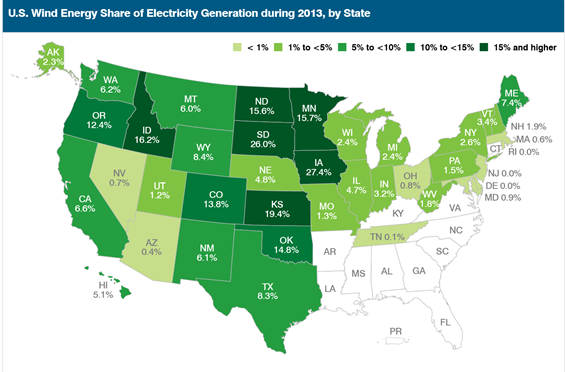Industry leaders committed to moving U.S. wind energy forward today at the WINDPOWER 2014 Conference & Exhibition, saying they can deliver an affordable solution to climate change and continue the industry’s extraordinary record of driving down the cost of its clean energy product.
“The urgent need to dramatically reduce global carbon emissions brings incredible opportunity to our industry,” said Susan Reilly, CEO of RES Americas and new chair of the AWEA Board of Directors, in her inaugural speech at Wednesday’s General Session.
Forty percent of all carbon emissions in the U.S. come from the electric power sector. Scientists say “decarbonizing” electricity is critical to holding carbon dioxide to a safer level in the atmosphere, and avoiding the worst impacts of climate change cost effectively, Reilly said.
“The facts are clear: After energy efficiency, wind energy is the fastest, cheapest way to get the biggest carbon reductions in our energy portfolio,” Reilly said. “So wind energy is no longer an ‘alternative’ – it is an imperative.”
Also underscoring the industry’s readiness to contribute even more to America on multiple fronts was David Danielson, Assistant Secretary in charge of the Office of Energy Efficiency and Renewable Energy at the Department of Energy (DOE). “The revolution is now,” said Danielson. “And right now, we have in this room everything we need to take wind energy to the next level.”
Preliminary findings of DOE’s Wind Vision, now about to enter further peer review, are that by 2050 wind energy can reach 35 percent of the U.S. grid; avoid 550 million metric tons of carbon dioxide emissions a year; create 400,000 industry jobs; and save consumers $520 billion. DOE staff will share more from their research on another WINDPOWER panel Thursday morning. The draft document will be circulated by June, and finalized this fall.
Leading a highly anticipated Wind Industry Leaders Panel, Reilly made clear the industry’s priorities, near-term and long-term. “We all know that we need another PTC extension this year,” she said, referring to wind’s primary policy driver, the federal Production Tax Credit. “But my major priority will be to ensure we get on a path to a rational, stable long-term policy to ensure that we deliver the Wind Vision.”
Mark Albenze, CEO of Siemens Energy Wind Power Americas, echoed Reilly’s comments on wind’s role in reversing climate change, calling wind “the immediate answer” to address the issue.
All agreed that the industry can continue to drive down the cost of wind energy, even after the recent 43 percent reduction in four years. “In order to keep reducing cost, it’s not only about turbine technology,” noted EDP Renewables North America CEO Gabriel Alonso. Costs can be brought down in other areas from the cost of raising capital to making wind farm operations more efficient, he said.
GE Renewable Energy President & CEO Anne M. McEntee agreed that opportunity abounds for further cost reduction, such as in more predictive maintenance and exploiting data and analytics in operations. “Those are the things that we need to be thinking about because it helps lower the overall cost of ownership, and that’s what’s going to help transform this industry,” she said.
Doug Fredrickson of Blattner Energy said the U.S. construction industry “is more than capable of building the 10 gigawatts” a year needed to reach 20 percent wind by 2030, as projected in the preliminary Wind Vision being discussed this week.
Seth Goldman, cofounder and President of Honest Tea, told attendees in his keynote address how he scaled up his company to the point it was acquired by Coca-Cola by stressing how its social and environmental mission make it different from tea as a commodity. He urged the wind industry to do likewise, by stressing the benefits of wind power versus generic electricity.
Reilly said the industry needs to emphasize how it can affordably reduce carbon, along with saving water and continuing local economic development, and that “as we succeed, our industry and our businesses will thrive.”
“If we don’t reduce carbon emissions now, the financial consequences to future generations and business interests will be much greater,” she said. “We will have to deliver the Wind Vision—we need this energy transformation.”


